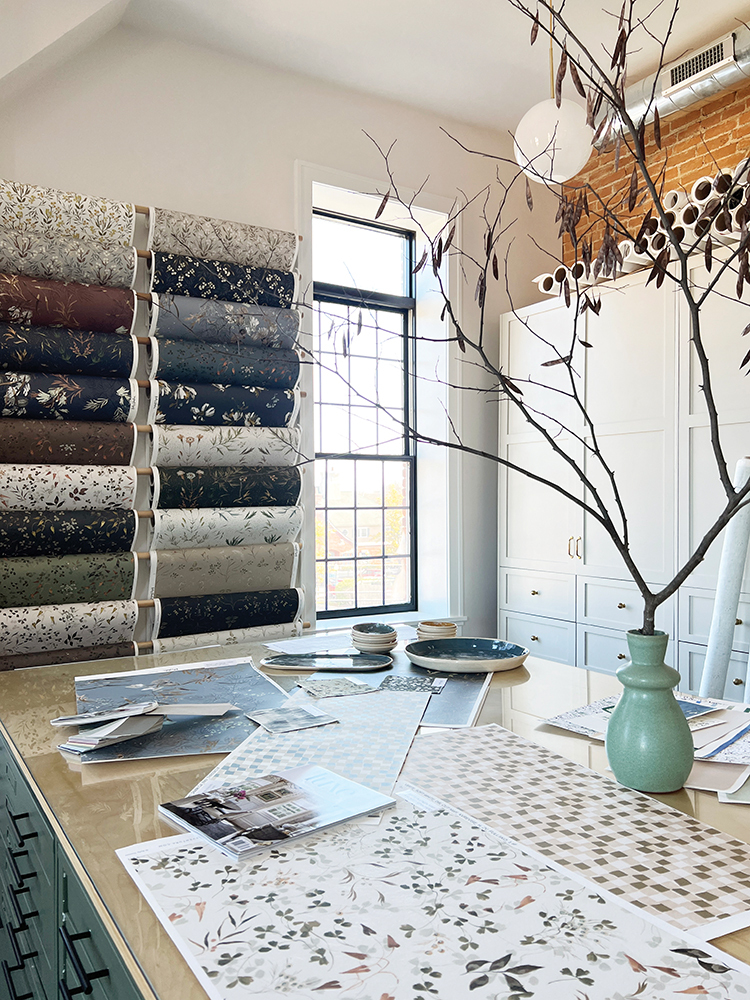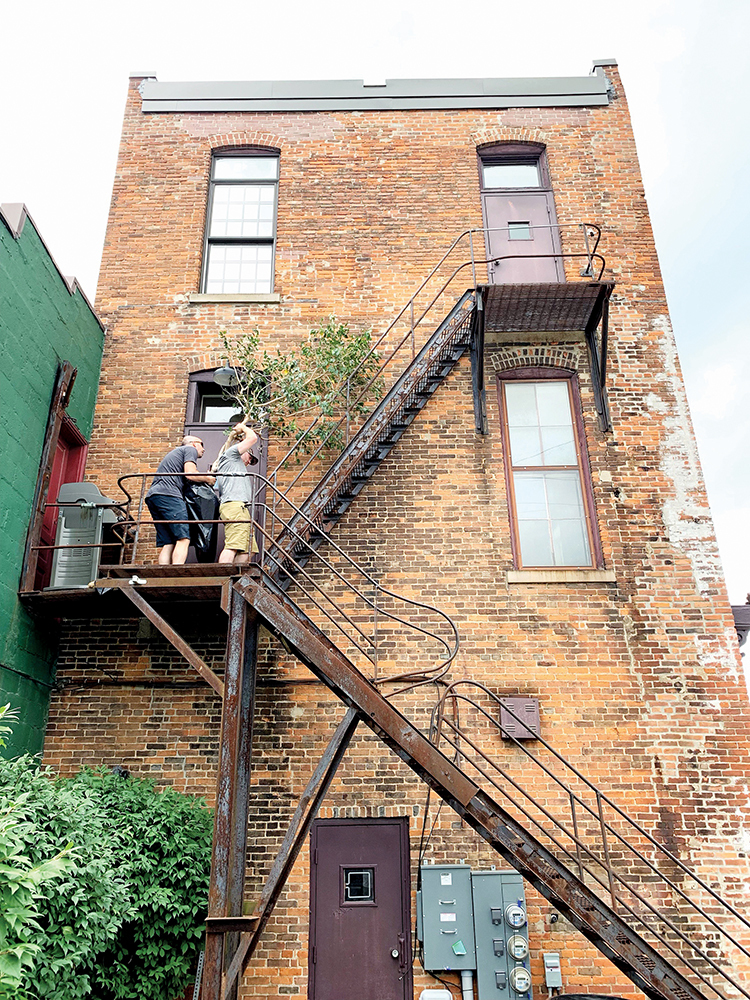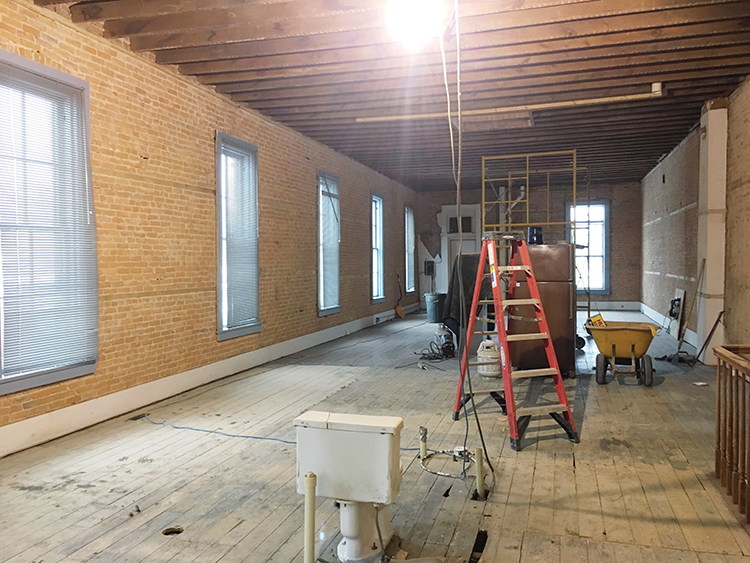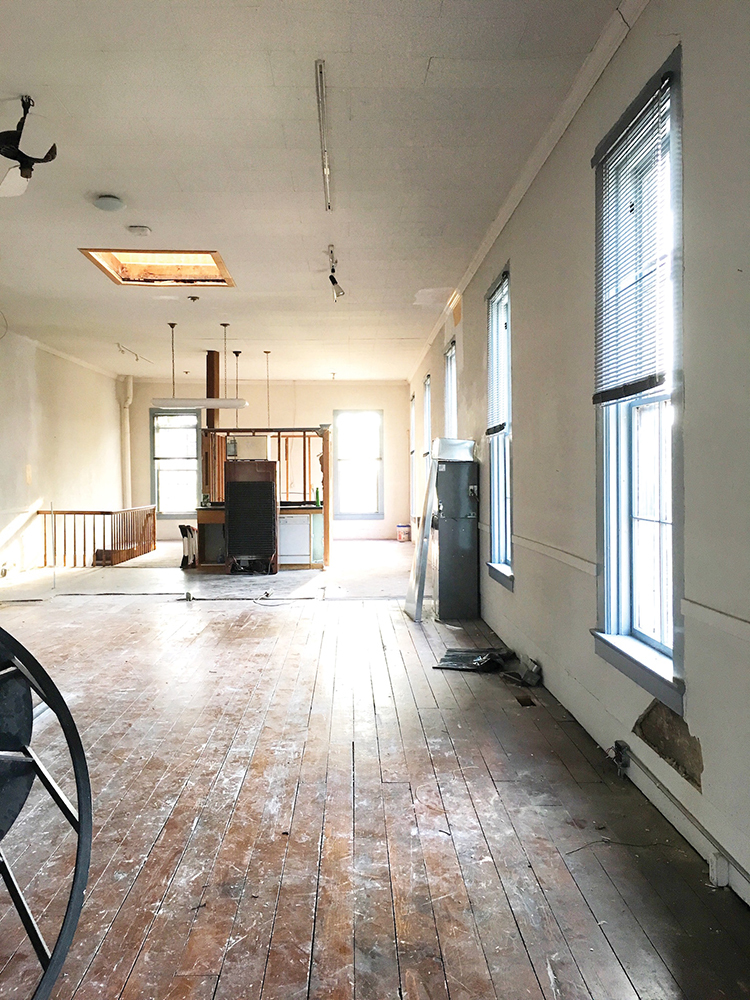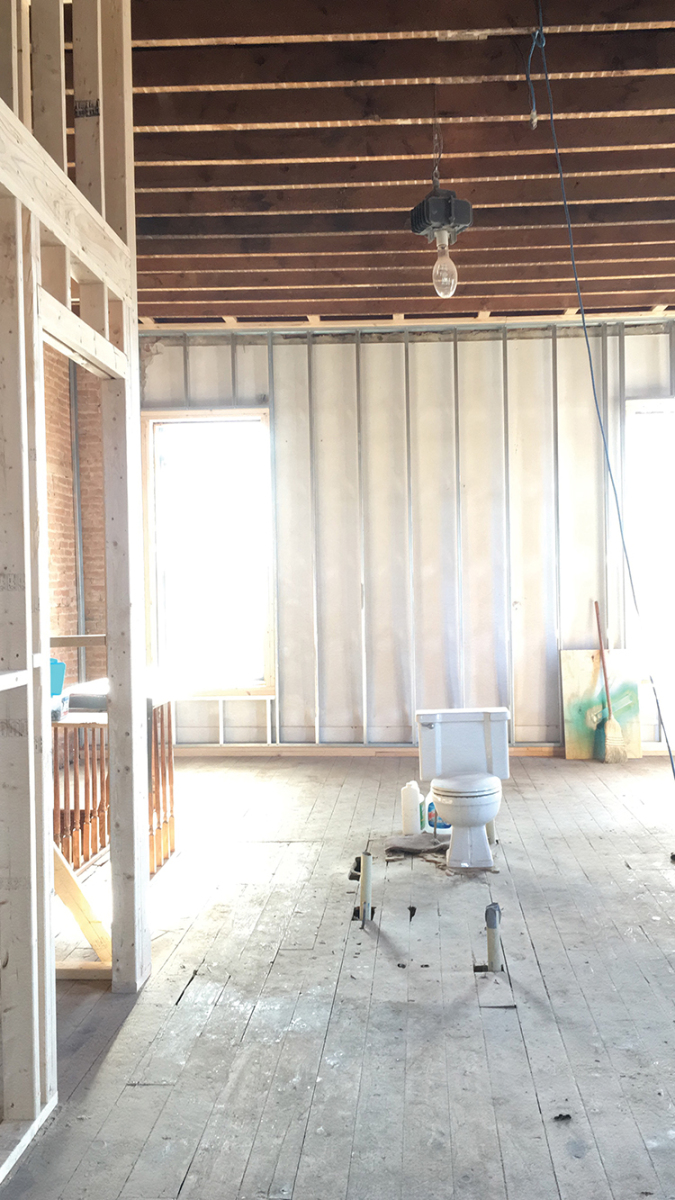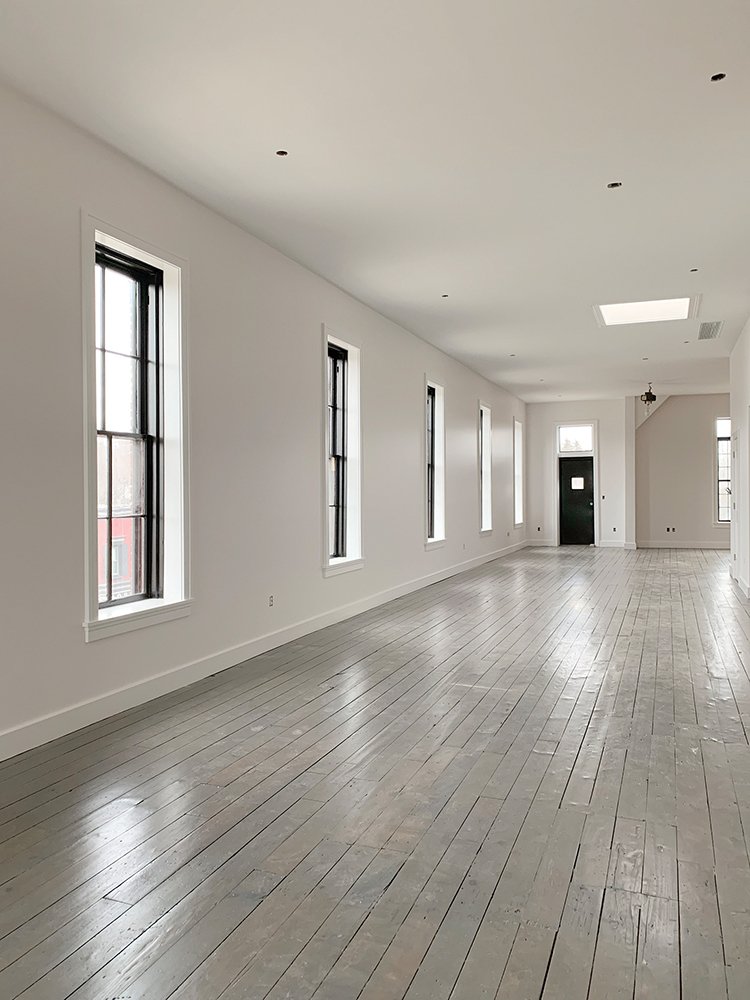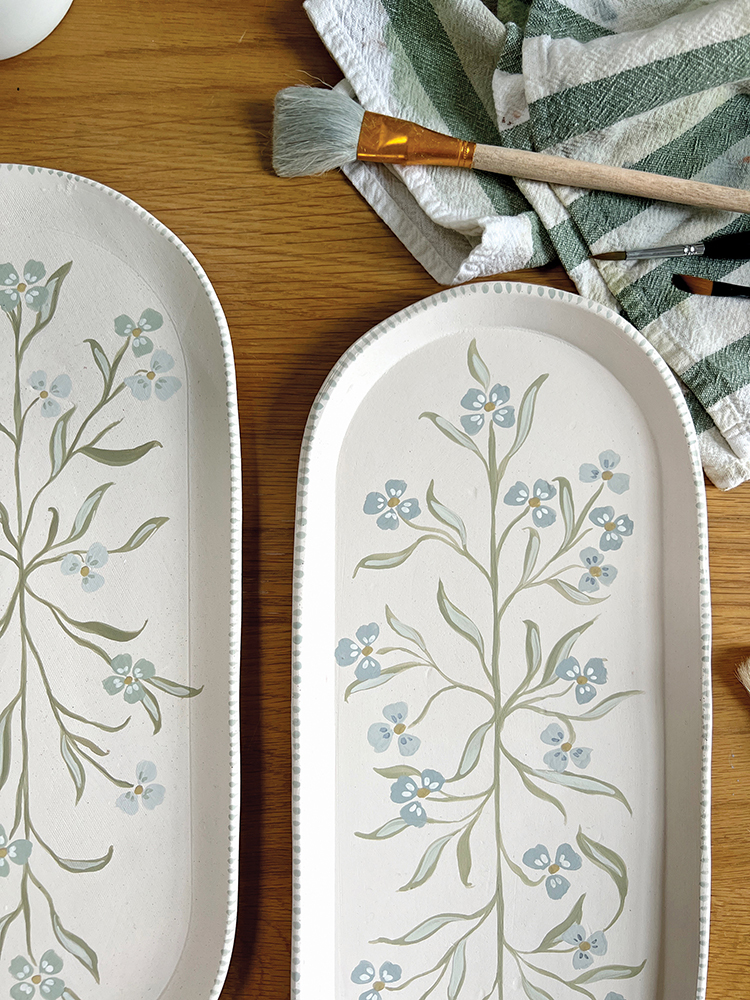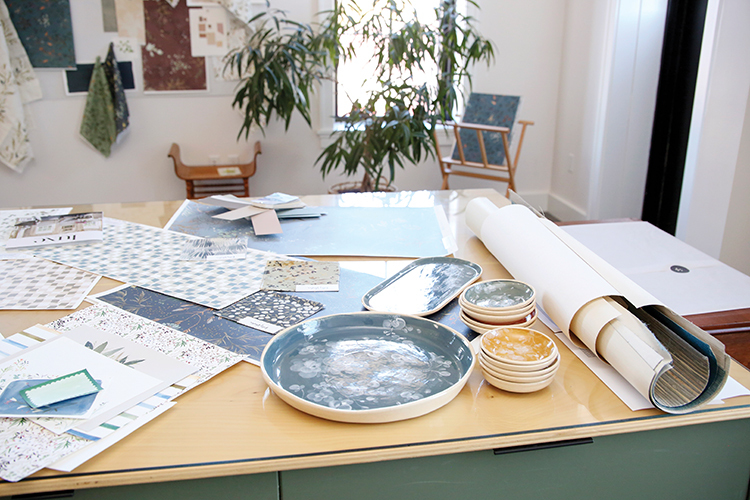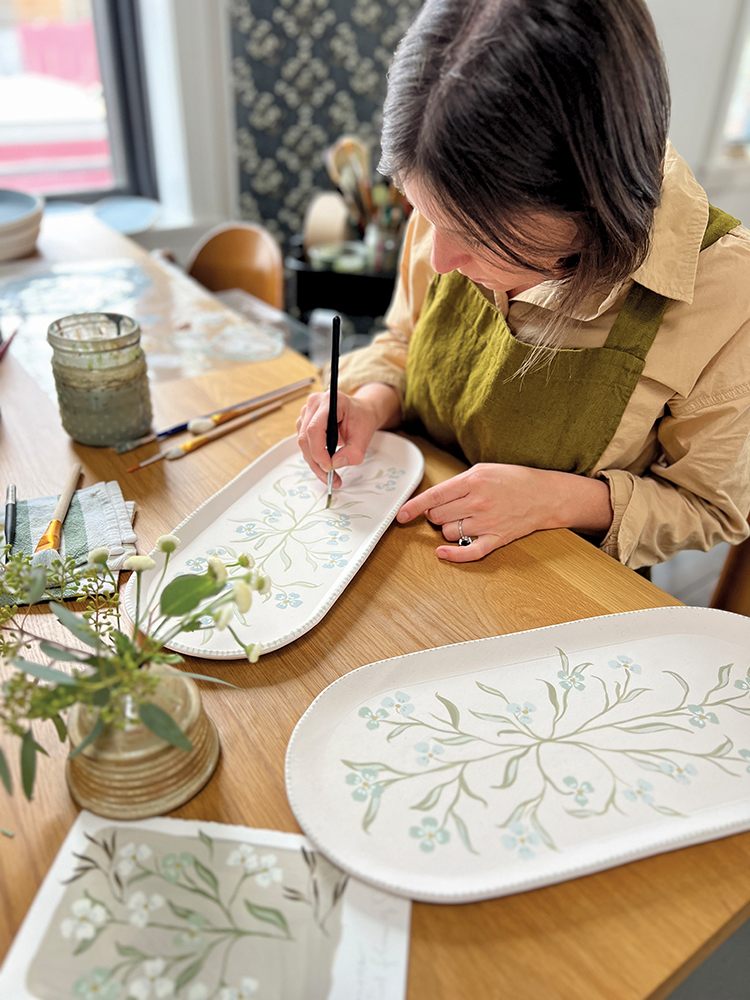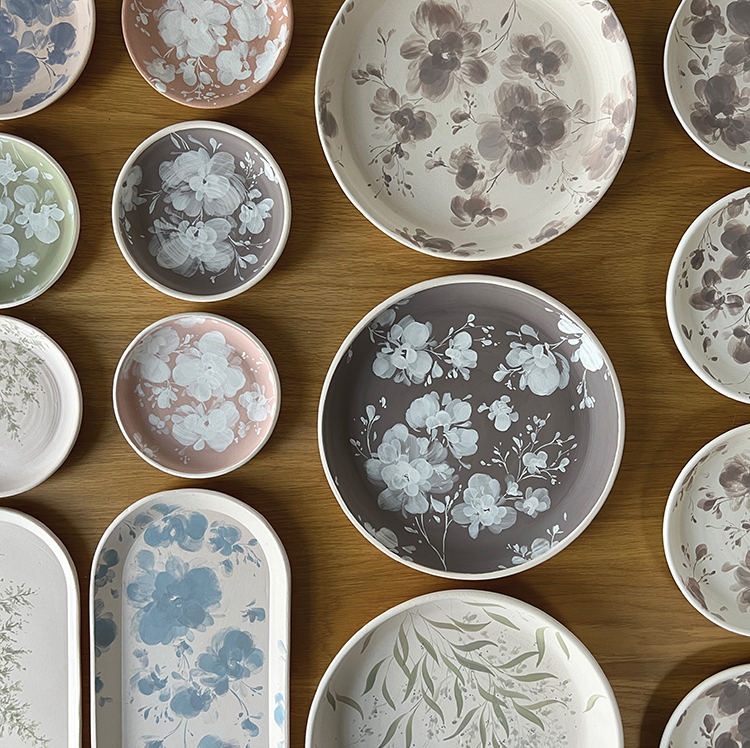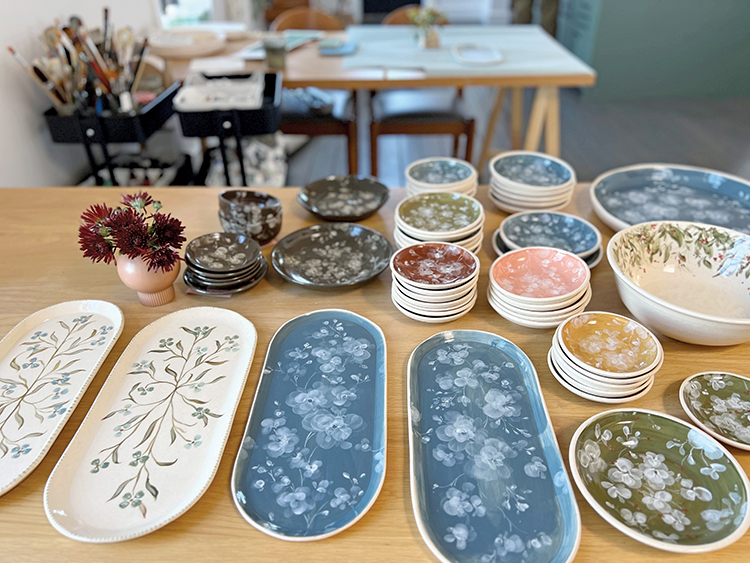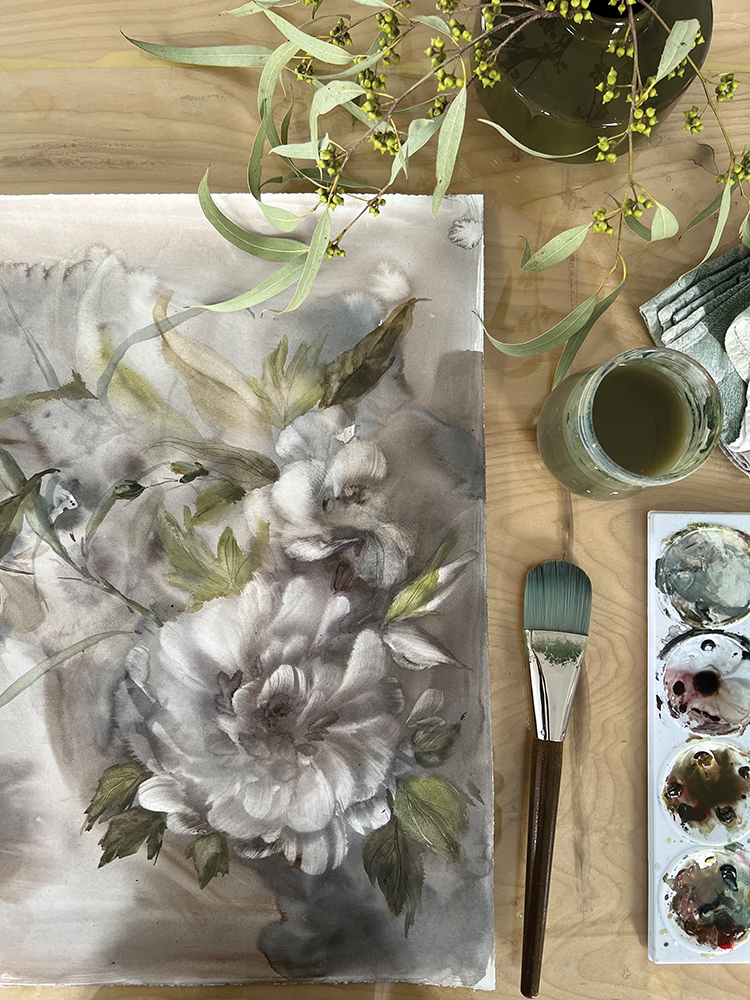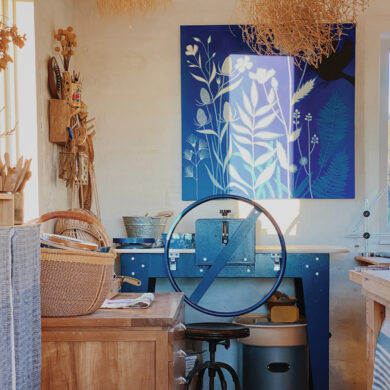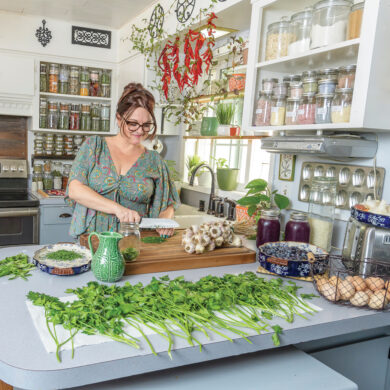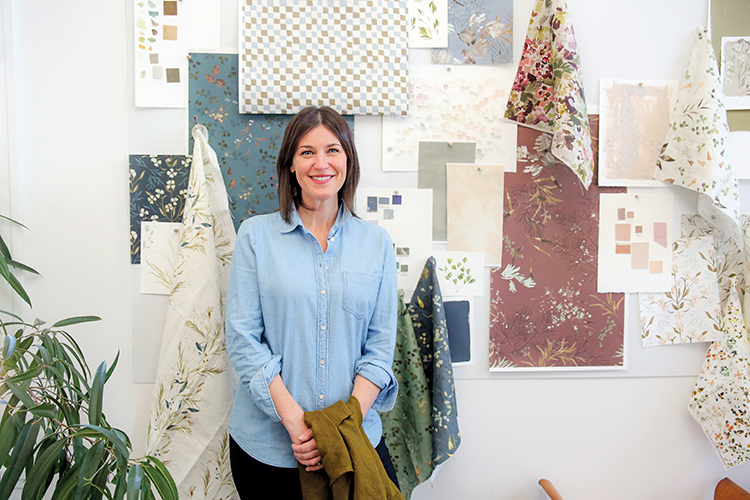
My creative journey has been a long one, full of big risks, successes, failures, steady growth and all the stuff that happens in between. This journey has been one of trusting the process, exploring the unknowns and being OK with failure, as it often leads and guides you into new, beautiful things. It’s something that I am proud of and love being able to share with an audience around the world from the comforts of my small-town Michigan studio.
I was always a creative kid and am told that my entrepreneurial career started at the ripe age of 6. I was mass-producing rainbow drawings in crayon by the dozen, selling each one on the sidewalk in front of my house for a nickel. My love of drawing, making and crafting continued through high school and into college, where I took a wide range of courses — from paper making to figurative studies, bookmaking to textiles and scientific illustration. I wasn’t great at everything, but there was something so intriguing about the process of creating: the mistakes, happy accidents and small successes.
I brought this exploratory energy with me post-college graduation as I moved east to intern in New York City, then onto Connecticut for bespoke wallpaper and rug designers. My short time spent with Elizabeth Dow and Emma Gardner Design opened my eyes to designing beautiful products and to the new-to-me world of surface design. This was a big moment for me, feeling like I knew what I wanted to do for a career! A few months later, I moved back to Michigan, bought a computer, taught myself the basics of Adobe Illustrator and started to build a portfolio.
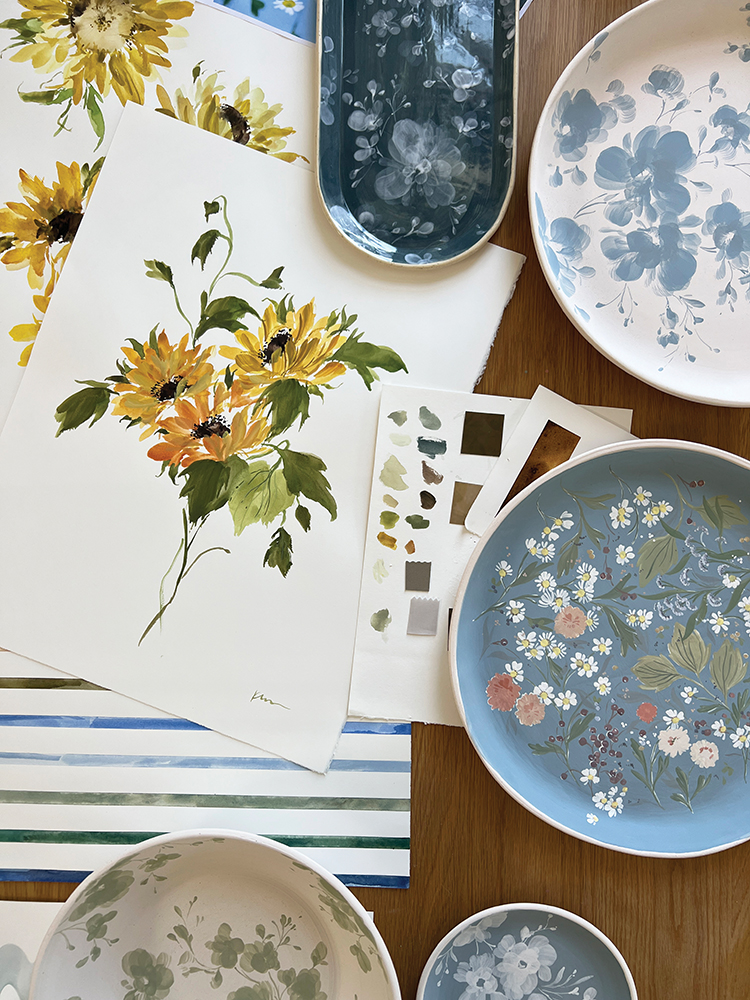
I was hired on as a product designer at Tag, a wholesale gift company, in Chicago, and spent the next five years churning out more snowmen, pumpkins and seasonal designs than I care to admit. It was also here that I learned so much about product development, timelines and building collections with a team. I had the privilege of traveling to Germany and Paris for sourcing trade shows and India for development trips. … It was truly the best first job ever. Sadly, I was let go in 2011, which stung at the time, but there was a whole new world waiting for me ahead.
As a new freelancer, I immediately started taking on a wide range of projects. From corporate map illustration to holiday stuffed animals to stationery design, I did it all. I worked in whatever style each company needed me to and it wasn’t until months later that I really started to think about spending time developing my own style. I had worked so heavily in vector-based art for the past six years, that when I took up painting again, it felt wonderfully freeing. I began working with watercolor in 2012, painting small, timid strokes, but with more practice, really started to loosen up and a more defined style began to emerge.
I was slowly building a cohesive body of work and began pitching to retailers and brands in hopes of a collaborating partnership. The amount of nos was really exhausting, but when that yes came, it was even sweeter, as it came from Crate & Barrel. We started with framed art prints and, during our 10-plus-year partnership, have collaborated on dinnerware, rugs, bedding, holiday goods and more. That was my first dip into art licensing, and I was hooked! From there, I exhibited at Surtex (an art licensing trade show) for two years, and created a robust art licensing business and product collaborations with Bloomingdale’s, IKEA, John Lewis, Land of Nod and Target. I loved having the opportunity to create all of these amazing products but was longing to create something of my own.
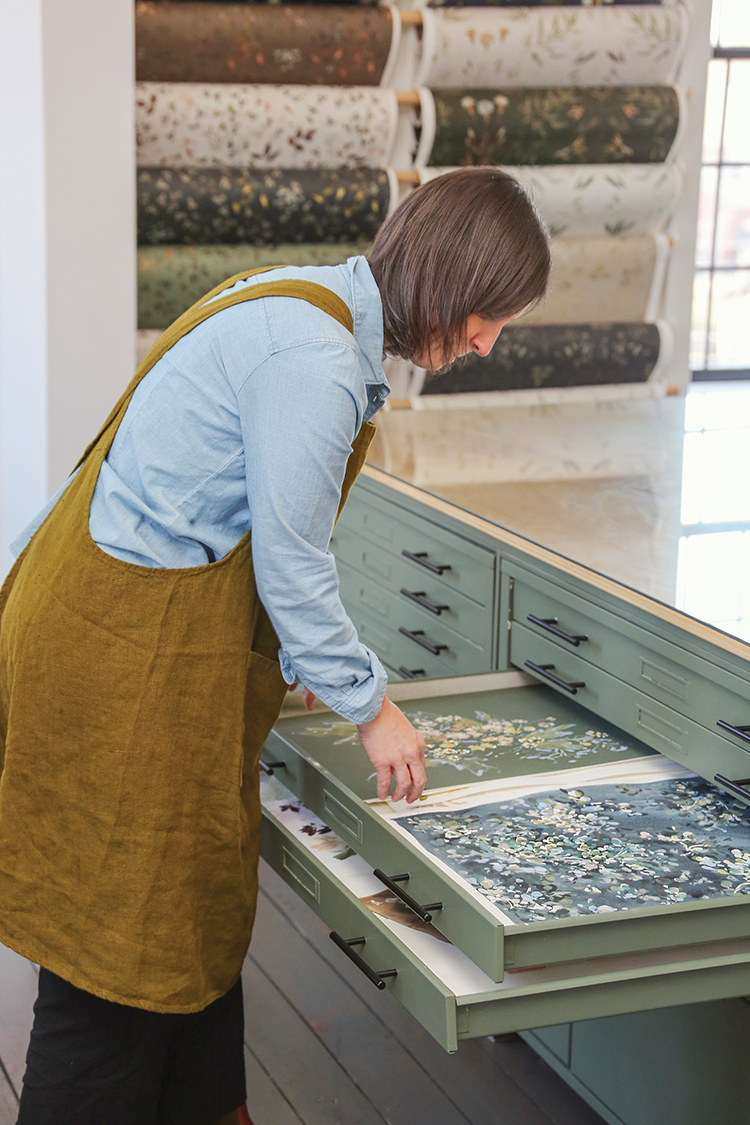
In 2017, Grace Bonney of Design*Sponge reposted an art print of mine on Instagram with a caption that read, “I would love to have this pattern as a wallpaper in my mudroom.” This was another one of those big moments for me. This was it — this was my product. This is what I wanted to create on my own! Another industry peer, Rebecca Atwood, commented on that same post and introduced me to her wallpaper manufacturer, who eventually became mine as well. I am still so grateful to Grace and Rebecca, as this Instagram post changed the course of my career in the best way possible.
I dove headfirst into a product and industry that I knew nothing about but landed in very good hands. My wallpaper manufacturing partners turned out to be more than just a printer and have been more like friends, mentors and cheerleaders since day one.
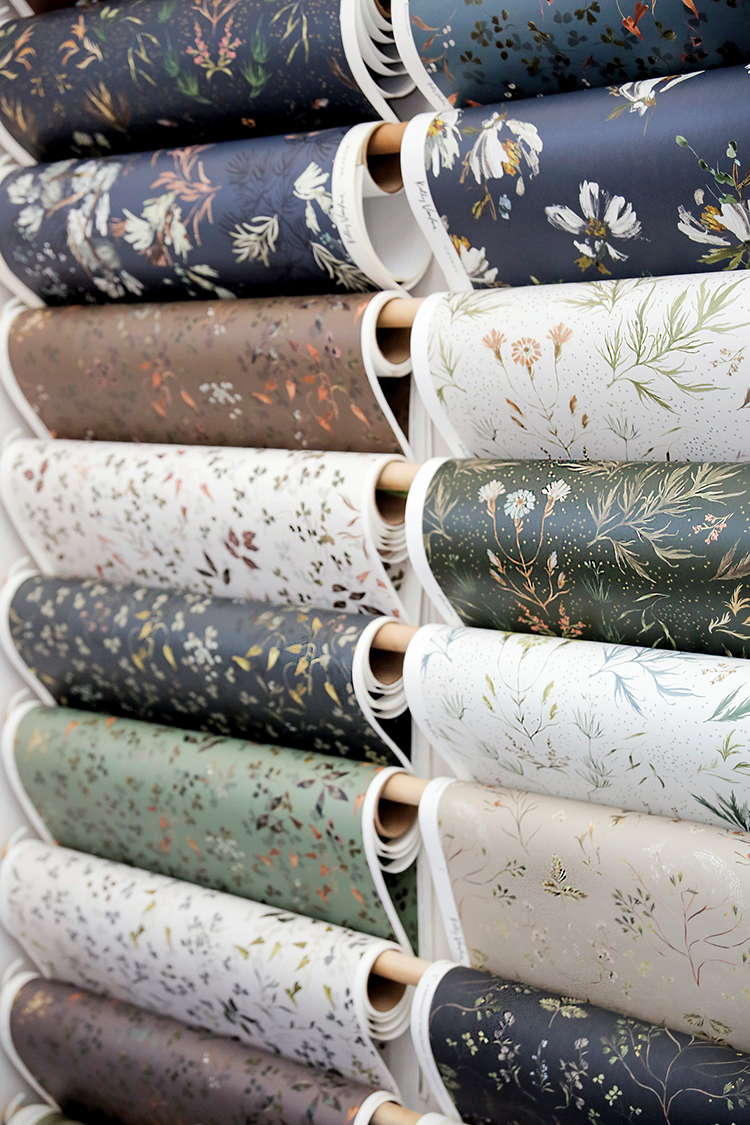
In my mind, I had planned to have tons and tons of wallpaper strike-offs made of my designs, but when I learned of the costs, I quickly panicked, retracted and asked for 10 strike-offs instead. When I arrived in Litchfield, Connecticut, to review strike-offs, twenty2 (wallpaper printer) had gone above and beyond, printed dozens and dozens of patterns, way beyond my request of 10. They were showing us what they were capable of and, also, what they believed our brand was capable of.
After seeing the possibilities on the wall that day, all of that earlier anxiety seemed to melt away. We launched wallpaper in 2018 and had a tremendous response to our collection. It’s been a steady growth, with the continued launch of new wallpaper collections and the expansion into textiles. Knowing that people are bringing a small piece of my work into their everyday lives, into their personal spaces and their homes, is something that inspires me to keep creating.
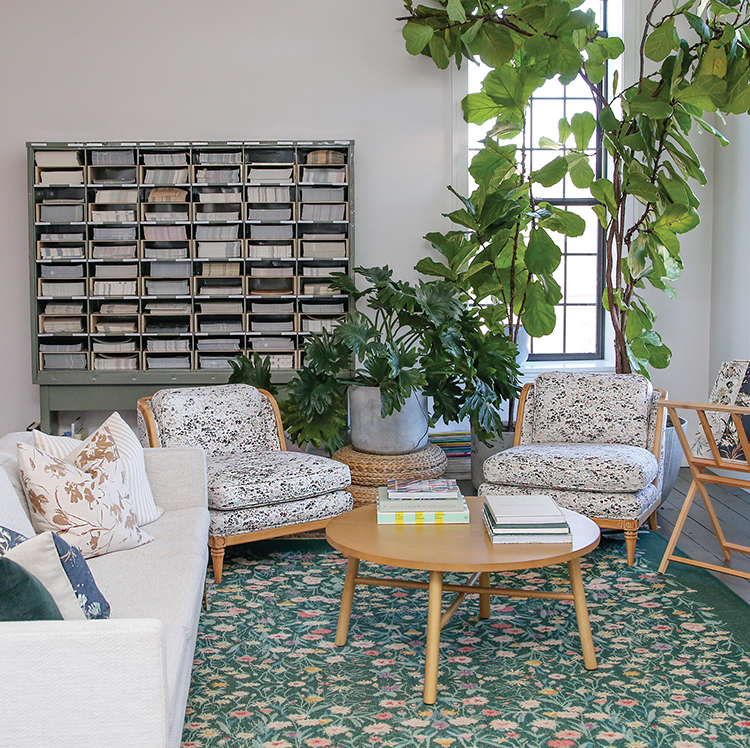
Speaking of homes, mine was bursting at the seams, with three young children and a rapidly growing business. I had completely grown out of my home studio, recently hired my sister Jen to work with me part time, and we were spreading operations across multiple rooms in my house. The days of working around mounds of laundry, baby gates and scatted toys were over: We needed space to spread out and plan for the next chapter of the business — wallpaper and textiles.
I wanted something close to home, near my boys’ school and childcare, and a place that felt like it was part of the community. I had spent a full year looking at buildings for lease in my town, coming up short with each viewing. As I drove through our small downtown one day, I happened to look up while sitting at a stoplight and saw a little square of sunlight streaming through the third floor of a historic building. For the first time in the few years that I’d lived in Milford, I noticed this old building as something different, not just the building that housed a shoe store on the first floor. Now, I saw it for its nine tall and incredible windows and skylight, a place that was bound to be full of beautiful natural light, which was an absolute must for our new studio space.
After tracking down the owners, I learned that the space had been vacant for five years, and that they had planned to renovate the unoccupied second and third floors into a single-family residence. They decided to show me the space, with no promise of renting it, and when I walked up the narrow flights of stairs, stepped into a room with crumbling plaster walls, holes in the floors and a toilet in the middle of the space, I knew instantly that it was perfect! Not only did they say “yes” to me leasing the space, but they also offered to renovate it to my specifications, as they had done plenty of these types of projects in the past. While they got to work on tearing it apart, I began dreaming up ideas for what it could become.
The building has an incredible past life, dating back to 1871 when it was built by Oliver H. St. John to house his jewelry store and bank. This historic building, the only three-story building in Milford’s commercial district, is known as the St. John Building. The third floor was known as St. John’s Hall, which was the fine entertainment hall for the town until the Opera House was built a few years later.
It was a full gut and took a year and a half of renovating, but it has been worth every ounce of waiting. We kept some of the original brick walls and salvaged the pine floors, and though it differs from the theater it once was, I love that the third floor remains a creative space all these years later.
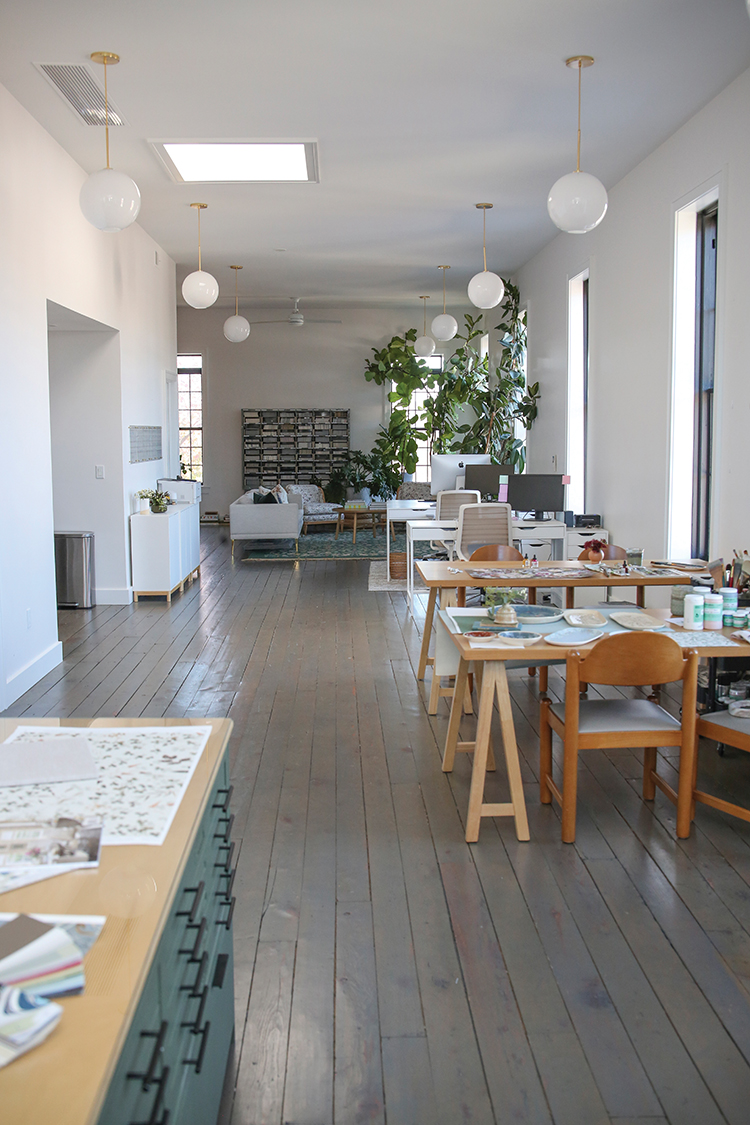
We have slowly furnished the studio to fit our ever-changing needs as we grow, adding desks as we hire, storage for inventory and proper space to spread out and create. The studio is filled with plants, many that have been purchased from estate sales and Facebook Marketplace. Plants that were in rough shape when we bought them, but ones that are absolutely thriving in this light-filled space, just as I am. As you look around the studio, you will find full tables of paintings, products, planning boards and messes from exploring mediums.
All these years later, I still carry that exploratory energy from my early days and have really leaned into allowing myself time to play. Making mistakes, stumbling on happy accidents, and feeling that spark — that is what keeps me going! Over the past four years in this space, no matter how busy my schedule is, I have been very intentional about making time to paint, just for myself. It’s my self-care, my way to discover new things. Spending an afternoon mixing colors and playing with new brushes with no result in mind is just as important as finishing a commission. This exploration is what has led me to create some of my best-selling wallpapers, hand-painted ornaments and, most recently, discover ceramics.
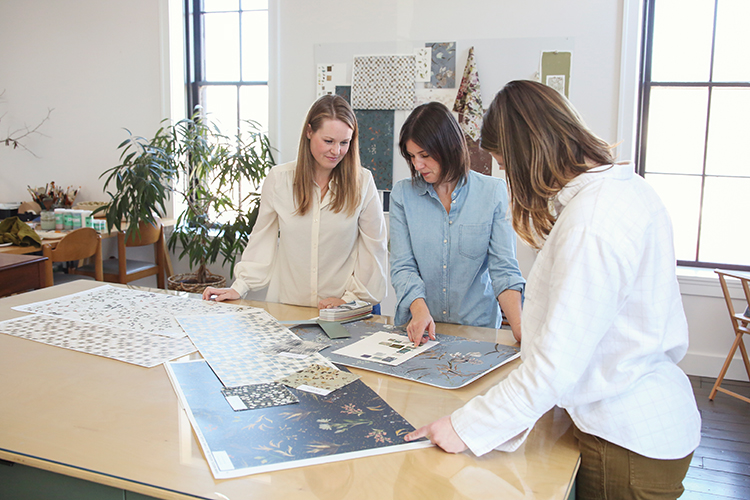
It’s this exploration that has helped me grow into becoming a more skilled watercolor artist; that the trial of new techniques, and different ways of layering and sometimes failing, is all part of the learning and growth process. Not knowing everything before starting something new is OK, and diving in is one of the best ways to learn, which is advice I share with young artists as often as possible.
The happiness that I feel when I’m creating in this space is truly a magical feeling. Though the end products are amazing, too, the process of getting there is like nothing else. I know that there is much more to come in how my art and business evolve and I’m excited to embrace the process as I have since the very beginning.

My creative journey has been a long one, full of big risks, successes, failures, steady growth and all the stuff that happens in between. This journey has been one of trusting the process, exploring the unknowns and being OK with failure, as it often leads and guides you into new, beautiful things. It’s something that I am proud of and love being able to share with an audience around the world from the comforts of my small-town Michigan studio.
I was always a creative kid and am told that my entrepreneurial career started at the ripe age of 6. I was mass-producing rainbow drawings in crayon by the dozen, selling each one on the sidewalk in front of my house for a nickel. My love of drawing, making and crafting continued through high school and into college, where I took a wide range of courses — from paper making to figurative studies, bookmaking to textiles and scientific illustration. I wasn’t great at everything, but there was something so intriguing about the process of creating: the mistakes, happy accidents and small successes.
I brought this exploratory energy with me post-college graduation as I moved east to intern in New York City, then onto Connecticut for bespoke wallpaper and rug designers. My short time spent with Elizabeth Dow and Emma Gardner Design opened my eyes to designing beautiful products and to the new-to-me world of surface design. This was a big moment for me, feeling like I knew what I wanted to do for a career! A few months later, I moved back to Michigan, bought a computer, taught myself the basics of Adobe Illustrator and started to build a portfolio.

I was hired on as a product designer at Tag, a wholesale gift company, in Chicago, and spent the next five years churning out more snowmen, pumpkins and seasonal designs than I care to admit. It was also here that I learned so much about product development, timelines and building collections with a team. I had the privilege of traveling to Germany and Paris for sourcing trade shows and India for development trips. … It was truly the best first job ever. Sadly, I was let go in 2011, which stung at the time, but there was a whole new world waiting for me ahead.
As a new freelancer, I immediately started taking on a wide range of projects. From corporate map illustration to holiday stuffed animals to stationery design, I did it all. I worked in whatever style each company needed me to and it wasn’t until months later that I really started to think about spending time developing my own style. I had worked so heavily in vector-based art for the past six years, that when I took up painting again, it felt wonderfully freeing. I began working with watercolor in 2012, painting small, timid strokes, but with more practice, really started to loosen up and a more defined style began to emerge.
I was slowly building a cohesive body of work and began pitching to retailers and brands in hopes of a collaborating partnership. The amount of nos was really exhausting, but when that yes came, it was even sweeter, as it came from Crate & Barrel. We started with framed art prints and, during our 10-plus-year partnership, have collaborated on dinnerware, rugs, bedding, holiday goods and more. That was my first dip into art licensing, and I was hooked! From there, I exhibited at Surtex (an art licensing trade show) for two years, and created a robust art licensing business and product collaborations with Bloomingdale’s, IKEA, John Lewis, Land of Nod and Target. I loved having the opportunity to create all of these amazing products but was longing to create something of my own.

In 2017, Grace Bonney of Design*Sponge reposted an art print of mine on Instagram with a caption that read, “I would love to have this pattern as a wallpaper in my mudroom.” This was another one of those big moments for me. This was it — this was my product. This is what I wanted to create on my own! Another industry peer, Rebecca Atwood, commented on that same post and introduced me to her wallpaper manufacturer, who eventually became mine as well. I am still so grateful to Grace and Rebecca, as this Instagram post changed the course of my career in the best way possible.
I dove headfirst into a product and industry that I knew nothing about but landed in very good hands. My wallpaper manufacturing partners turned out to be more than just a printer and have been more like friends, mentors and cheerleaders since day one.

In my mind, I had planned to have tons and tons of wallpaper strike-offs made of my designs, but when I learned of the costs, I quickly panicked, retracted and asked for 10 strike-offs instead. When I arrived in Litchfield, Connecticut, to review strike-offs, twenty2 (wallpaper printer) had gone above and beyond, printed dozens and dozens of patterns, way beyond my request of 10. They were showing us what they were capable of and, also, what they believed our brand was capable of.
After seeing the possibilities on the wall that day, all of that earlier anxiety seemed to melt away. We launched wallpaper in 2018 and had a tremendous response to our collection. It’s been a steady growth, with the continued launch of new wallpaper collections and the expansion into textiles. Knowing that people are bringing a small piece of my work into their everyday lives, into their personal spaces and their homes, is something that inspires me to keep creating.

Speaking of homes, mine was bursting at the seams, with three young children and a rapidly growing business. I had completely grown out of my home studio, recently hired my sister Jen to work with me part time, and we were spreading operations across multiple rooms in my house. The days of working around mounds of laundry, baby gates and scatted toys were over: We needed space to spread out and plan for the next chapter of the business — wallpaper and textiles.
I wanted something close to home, near my boys’ school and childcare, and a place that felt like it was part of the community. I had spent a full year looking at buildings for lease in my town, coming up short with each viewing. As I drove through our small downtown one day, I happened to look up while sitting at a stoplight and saw a little square of sunlight streaming through the third floor of a historic building. For the first time in the few years that I’d lived in Milford, I noticed this old building as something different, not just the building that housed a shoe store on the first floor. Now, I saw it for its nine tall and incredible windows and skylight, a place that was bound to be full of beautiful natural light, which was an absolute must for our new studio space.
After tracking down the owners, I learned that the space had been vacant for five years, and that they had planned to renovate the unoccupied second and third floors into a single-family residence. They decided to show me the space, with no promise of renting it, and when I walked up the narrow flights of stairs, stepped into a room with crumbling plaster walls, holes in the floors and a toilet in the middle of the space, I knew instantly that it was perfect! Not only did they say “yes” to me leasing the space, but they also offered to renovate it to my specifications, as they had done plenty of these types of projects in the past. While they got to work on tearing it apart, I began dreaming up ideas for what it could become.
The building has an incredible past life, dating back to 1871 when it was built by Oliver H. St. John to house his jewelry store and bank. This historic building, the only three-story building in Milford’s commercial district, is known as the St. John Building. The third floor was known as St. John’s Hall, which was the fine entertainment hall for the town until the Opera House was built a few years later.
It was a full gut and took a year and a half of renovating, but it has been worth every ounce of waiting. We kept some of the original brick walls and salvaged the pine floors, and though it differs from the theater it once was, I love that the third floor remains a creative space all these years later.

We have slowly furnished the studio to fit our ever-changing needs as we grow, adding desks as we hire, storage for inventory and proper space to spread out and create. The studio is filled with plants, many that have been purchased from estate sales and Facebook Marketplace. Plants that were in rough shape when we bought them, but ones that are absolutely thriving in this light-filled space, just as I am. As you look around the studio, you will find full tables of paintings, products, planning boards and messes from exploring mediums.
All these years later, I still carry that exploratory energy from my early days and have really leaned into allowing myself time to play. Making mistakes, stumbling on happy accidents, and feeling that spark — that is what keeps me going! Over the past four years in this space, no matter how busy my schedule is, I have been very intentional about making time to paint, just for myself. It’s my self-care, my way to discover new things. Spending an afternoon mixing colors and playing with new brushes with no result in mind is just as important as finishing a commission. This exploration is what has led me to create some of my best-selling wallpapers, hand-painted ornaments and, most recently, discover ceramics.

It’s this exploration that has helped me grow into becoming a more skilled watercolor artist; that the trial of new techniques, and different ways of layering and sometimes failing, is all part of the learning and growth process. Not knowing everything before starting something new is OK, and diving in is one of the best ways to learn, which is advice I share with young artists as often as possible.
The happiness that I feel when I’m creating in this space is truly a magical feeling. Though the end products are amazing, too, the process of getting there is like nothing else. I know that there is much more to come in how my art and business evolve and I’m excited to embrace the process as I have since the very beginning.








